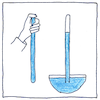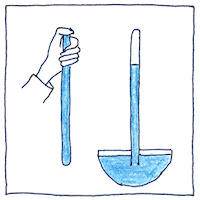Evangelista Torricelli,
Blaise Pascal
atmospheric sciences

|
Atmospheric pressure
Evangelista Torricelli, a student of Galileo, invented the mercury barometer, but its use created a mystery that scientists before Pascal could not explain. Torricelli showed that if you take a glass tube closed on one end, fill it with mercury, and invert it into a cistern, not all of the mercury leaves the tube, leaving a gap at the closed end. Water barometers had been made before but no one before Torricelli realized that the weight of the atmosphere balanced the weight of the liquid in the tube. The difficulty was that scientists believed that air was weightless and that a vacuum was an impossibility. After all, if nothing was in the gap then what propagated the light? Pascal showed that the gap was a vacuum, that the mechanical weight of the atmosphere decreased as you ascended. If you hike high enough, you would reach the vacuum of space.
Perspective
From an airplane window Canada looks flat. Mountains and valleys are smashed into a plain of snow.
Perfectly good logic
Perfectly good logic can begin with foregone conclusions. Perfectly good logic convinced everyone light couldn’t pass through a vacuum. But that was when outer space was filled with luminiferous aether and air with phlogiston.



Torricelli was the first scientist to point out that wind is caused by differences of atmospheric pressure.
Pascal’s law applies to liquids and gases. Pressure on a fluid at any point is transmitted undiminished throughout the fluid to all constraining points. Equal areas experience equal pressure, so that the pressure transmitted to an area is proportional to the size of the area.
Otto von Guericke invented the first vacuum pump and conducted his famous Magdeburg hemispheres experiment to demonstrate the force of atmospheric pressure.
See also in The book of science:
Readings in wikipedia: